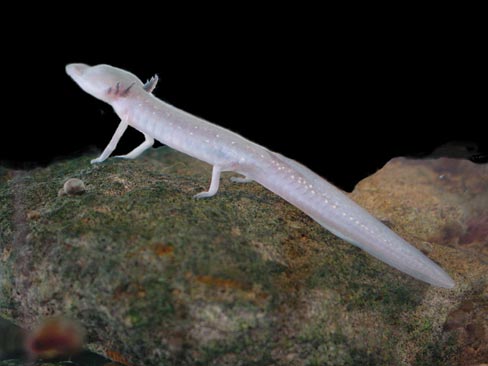|
Troglomorphic
Troglomorphism is the morphological adaptation of an animal to living in the constant darkness of caves, characterised by features such as loss of pigment, reduced eyesight or blindness, and frequently with attenuated bodies and/or appendages. The terms troglobitic, stygobitic, stygofauna, troglofauna, and hypogean or hypogeic, are often used for cave-dwelling organisms. A 2012 study by a team from the National University of Singapore found that reductive changes in freshwater cave crabs evolved at the same rate as constructive changes. This shows that both selection and evolution have a role in advancing reductive changes (e.g smaller eyes) and constructive changes (e.g larger claws), making troglomorphic adaptations subject to strong factors that affect an organism's morphology. Troglomorphism occurs in molluscs, velvet worms, arachnids, myriapods, crustaceans, insects, fish, amphibians (notably cave salamanders) and reptiles. To date no mammals or birds have been found to liv ... [...More Info...] [...Related Items...] OR: [Wikipedia] [Google] [Baidu] |
Cavefish
Cavefish or cave fish is a generic term for fresh and brackish water fish adapted to life in caves and other underground habitats. Related terms are subterranean fish, troglomorphic fish, troglobitic fish, stygobitic fish, phreatic fish and hypogean fish.Romero, Aldemaro, editor (2001). ''The Biology of Hypogean Fishes.'' Developments in Environmental Biology of Fishes. Helfman, G.S. (2007). ''Fish Conservation: A Guide to Understanding and Restoring Global Aquatic Biodiversity and Fishery Resources'', pp. 41–42. Island Press. There are more than 200 scientifically described species of obligate cavefish found on all continents, except Antarctica. Although widespread as a group, many cavefish species have very small ranges and are seriously threatened.Fenolio, D.B.; Zhao, Y.; Niemiller, M.L.; and Stout, J. (2013). ''In-situ observations of seven enigmatic cave loaches and one cave barbel from Guangxi, China, with notes on conservation status.'' Speleobiology Notes 5: 19-33.Proud ... [...More Info...] [...Related Items...] OR: [Wikipedia] [Google] [Baidu] |
